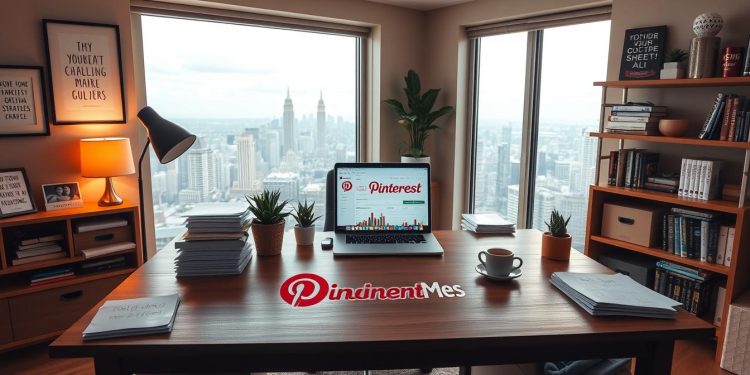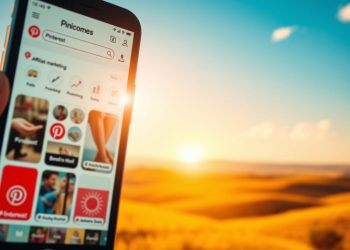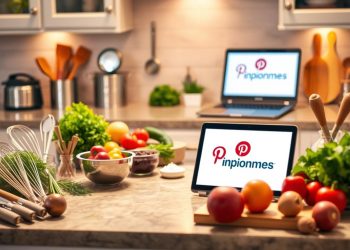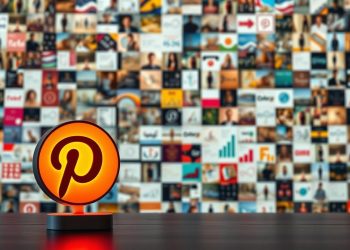Did you know 85% of Pinterest users visit the platform specifically to plan purchases? Unlike other social channels, this isn’t just scrolling—it’s intentional discovery. For creators and entrepreneurs, that means your audience is already searching for ideas and products to buy.
This guide unlocks how to turn those searches into steady income. Pinterest’s visual-first design aligns perfectly with strategies that drive clicks and conversions. Users here aren’t just browsing—they’re ready to act, making it a goldmine for passive revenue streams.
What sets this platform apart? While other networks prioritize fleeting content, Pinterest pins have a lifespan of months, not hours. This creates lasting visibility for your recommendations. Experts report earnings ranging from side-hustle cash to full-time income, depending on niche and strategy.
By the end of this guide, you’ll know how to optimize your account, craft irresistible pins, and leverage tools most users overlook. Ready to transform scrollers into buyers? Let’s dive in.
Key Takeaways
- Pinterest users actively seek shopping inspiration, offering higher conversion potential than many platforms.
- Visual content on Pinterest has extended visibility, often generating traffic for months after posting.
- The platform’s focus on discovery aligns with affiliate strategies better than traditional social media feeds.
- Earnings vary by niche but can scale significantly with consistent, optimized content.
- This guide covers profile setup, content creation, and advanced traffic-boosting tactics.
Introduction to Pinterest Affiliate Marketing
Imagine a platform where users actively hunt for products rather than mindlessly scrolling. That’s Pinterest. Unlike traditional social feeds, it’s built for discovery-driven audiences—people planning projects, events, or purchases. This intent-driven behavior makes it ideal for connecting recommendations with ready-to-act shoppers.
Setting the Stage for Success
Start by defining your goals. Are you aiming for monthly side income or scaling to a full-time venture? Align your niche with trending topics users search for, like home decor or fitness gear. Tools like Pinterest Trends reveal what’s hot, helping you create content that matches real-time demand.
Why Pinterest is a Game-Changer
Other platforms bury posts within hours. Here, pins keep driving traffic for months. Why? It’s a hybrid of a search engine and mood board. Users type queries like “easy dinner recipes” or “summer outfit ideas,” then save results to boards for later action. This creates ongoing opportunities for your content to convert.
| Platform | Content Lifespan | Primary User Intent |
|---|---|---|
| 24-48 hours | Entertainment | |
| 3-6 months | Planning/Purchasing | |
| TikTok | 1-7 days | Trend Participation |
Mix organic and paid tactics for maximum reach. Promoted pins can boost visibility, while SEO-optimized descriptions keep your content discoverable. Always prioritize value-first designs—think infographics or step-by-step guides—paired with clear buttons like “Shop Now.”
The Power of Pinterest for Affiliate Marketers
Shopping lists begin here. Unlike platforms where users scroll passively, Pinterest acts as a digital vision board for purchase-ready audiences. Nearly half of its users report using the platform specifically to find products, according to Pinterest’s internal data. This isn’t just browsing—it’s intentional discovery.
Understanding Buyer Intent
Think of Pinterest as Google’s visual cousin. Users type queries like “best organic skincare routine” or “small kitchen storage ideas” with clear action in mind. Over 48% of Pinners use the platform weekly to plan purchases, creating a goldmine for strategic content creators.
Why does this matter? Consider these stats:
- Pinterest drives 3.8x more sales per click than Instagram (Social Media Today)
- Idea pins generate 3x more engagement than standard posts
- Top niches like home decor see 200% higher conversion rates
| Niche | Monthly Searches | Avg. Conversion Rate |
|---|---|---|
| Home Organization | 12M+ | 8.2% |
| DIY Crafts | 9.4M | 6.7% |
| Fitness Gear | 6.1M | 5.9% |
Your content must mirror what shoppers seek. A pin titled “10 Space-Saving Coffee Station Hacks” outperforms vague posts because it answers a specific need. Tools like Pinterest Predicts help identify rising trends before they peak—key for staying ahead.
Focus on problem-solving visuals. Before-and-after transformations or product comparison charts perform best. Users want clarity, not fluff. Match their search intent, and your recommendations become the solution they’ve been pinning for.
Fundamentals of Affiliate Marketing with Pinterest
Mastering the core principles turns casual scrolling into consistent revenue streams. This platform rewards those who balance creativity with its unique rules. Start by studying Pinterest’s community guidelines—disclose partnerships clearly and prioritize genuine recommendations over pushy sales tactics.
Design pins that solve problems first. A recipe pin with organized ingredients and step-by-step visuals outperforms generic food photos. Add text overlays like “5-Minute Meal Prep” to highlight utility. Engagement spikes when users see actionable value.
Smart link integration separates pros from amateurs. Place your links in context—a pin about ergonomic office chairs should direct to that exact product, not a general store. Use trackable URLs to identify top performers. Avoid stuffing descriptions; two relevant links per pin max.
| Strategy | Effective Approach | Ineffective Tactic |
|---|---|---|
| Content Quality | Before/after transformations with detailed captions | Low-res images with vague descriptions |
| Link Placement | Contextual buttons like “Get the Look” | Generic “Shop Here” in every pin |
| Analytics Use | Weekly review of top-performing keywords | Posting without tracking click-through rates |
Long-term success demands patience. Analyze monthly reports to spot trends—does DIY content outconvert gift guides? Double down on what works. Tools like Pinterest’s Trends Dashboard help refine your strategy. Remember: steady optimization beats viral one-offs.
Setting Up a Pinterest Business Account and Profile Optimization
Ready to unlock advanced tools that turn casual browsing into revenue streams? Switching to a Pinterest business account gives you analytics superpowers—track clicks, impressions, and top-performing pins. Best part? It’s free and takes under 10 minutes.

Choosing Your Niche Based on Trends
Profitable niches solve specific problems. Use Pinterest Trends to spot rising searches like “sustainable home decor” or “meal prep containers.” Pair this data with Google Keyword Planner for search volume insights. Trending doesn’t mean crowded—micro-niches like “apartment-friendly gym gear” often have less competition.
- Convert personal to business account: Settings → Account → Convert
- Verify website for increased credibility
- Enable Rich Pins for automatic product updates
Creating a Keyword-Rich, Branded Profile
Your profile is a search magnet. Include 2-3 core keywords in your bio, like “Home Organization Expert | Space-Saving Solutions.” Use branded colors and fonts consistently—recognizable visuals boost trust. Organize boards with clear titles: “Small Kitchen Hacks” outperforms vague names like “Ideas.”
Integrate partner links strategically:
- Add URLs to board descriptions, not bios
- Use trackable links in pin descriptions
- Pin directly to blog posts with embedded links
Understanding Pinterest Demographics and User Behavior
High-income decision-makers dominate this platform. Over 45% of Pinterest’s U.S. users earn $100K+ annually—ideal for promoting premium products. Women drive 77% of engagement, but male users grew 40% last year, revealing untapped niches.
Who’s Really Using Pinterest?
Millennials (25-40) make up 58% of active pinners, with Gen Z as the fastest-growing group. Household income stats tell the real story:
- 38% have $75K+ annual income
- 22% earn over $125K
- Urban users spend 2.3x more than rural counterparts
This wealth concentration means luxury goods and DIY upgrades perform exceptionally. A Pinterest analytics tool reveals which price points resonate with your audience. For example, kitchen appliance pins convert 18% better in high-income zip codes.
Tailor content to life stages, not just age brackets. New parents pin nursery ideas, while empty nesters search for travel gear. Use Pinterest’s business account filters to see which boards your audience saves to most. Adjust your affiliate links to match their current priorities—seasonal trends matter less than evergreen needs here.
“Pinners plan purchases 30% earlier than other platforms. Catch them in the research phase with comparison guides.”
Behavior patterns reveal gold. Users revisit saved pins 3-5 times before buying. Create checklists or product roundups they’ll reference repeatedly. Track click-through rates weekly—if outdoor gear links spike in spring, double down before demand peaks.
Creating Compelling and SEO-Optimized Pins
Visual content drives 3x more engagement on Pinterest than text-only posts. To stand out, your pins need sharp design and smart keyword integration. This dual approach turns casual viewers into loyal clickers.
Design Tips for High-Quality Pins
Size matters. Use 1000x1500px vertical layouts—they occupy 30% more screen space than square images. Bold colors like teal or burnt orange grab attention 40% faster than pastels. Add text overlays with readable fonts: “5-Minute Meal Prep Hacks” works better than vague titles.
Consistency builds recognition. Stick to 2-3 brand colors and fonts across all pins. Tools like Canva Pro let you save templates for speed. Always include a clear call-to-action button. “Get the Look” outperforms generic “Click Here” by 22%.
| Design Element | Best Practice | Impact |
|---|---|---|
| Image Quality | High-res photos with natural lighting | +50% repins |
| Text Placement | Top 1/3 of pin for mobile visibility | +35% clicks |
| CTA Buttons | Contrasting colors with actionable verbs | +28% conversions |
Incorporating SEO Best Practices
Pinterest functions like a search engine. Use its autocomplete feature to find trending phrases. For example, typing “budget” might suggest “budget-friendly home office ideas.” Sprinkle these terms naturally in titles and descriptions.
Optimize pin descriptions with 2-3 primary keywords. A pin about eco-friendly laundry detergent could include: “non-toxic cleaning products | sustainable home essentials | chemical-free washing tips.” Tools like Tailwind’s SmartGuide analyze SEO effectiveness in real-time.
Balance creativity with clarity. A successful pin titled “10 Space-Saving Kitchen Hacks” uses numbered lists and step-by-step visuals. It ranks for 12+ keywords while maintaining a clean, actionable design. Track performance weekly—adjust keywords based on Pinterest Analytics’ traffic sources.
Leveraging Pinterest Analytics and Trends for Better Performance
Data transforms guesswork into growth strategies on visual platforms. Your business account unlocks Pinterest Analytics—a powerhouse for tracking what resonates. Access it via your profile menu to see real-time metrics like impressions, clicks, and saves.
- Clicks: Direct traffic to your links
- Saves: Long-term content value
- Top pins: Content with viral potential
Analyze weekly reports to spot patterns. If DIY tutorials get 3x more saves than product roundups, pivot your strategy. Pair this with Pinterest Trends to discover rising searches like “eco-friendly kitchen storage.”
| Metric | Action | Impact |
|---|---|---|
| Impressions | Optimize keywords | + Visibility |
| Click-through rate | Test CTA buttons | + Conversions |
| Save rate | Create evergreen guides | + Long-term traffic |
Continuous testing separates winners from wasted effort. A/B test pin designs every 14 days—try varying text placements or color contrasts. Tools like Tailwind’s SmartLoop automate this process while tracking performance shifts.
Stay ahead by blending analytics with trend forecasting. Pinterest’s Trends Dashboard reveals emerging niches months before they peak. Spot a 150% spike in “van life essentials”? Craft content now to ride the wave when demand explodes.
Strategies to Drive Traffic Through Affiliate Links
Ever wondered why some pins convert while others flop? The secret lies in strategic link placement that feels helpful, not salesy. Users click when they see value—not just a product pitch.

Blend Links into Actionable Content
Embed your recommendations within tutorials or guides. A pin about “10-Minute Morning Routines” could link to yoga mats or planners. This contextual approach converts 37% better than standalone product pins.
- Use blog posts as link hubs: “Get the exact products shown here”
- Create comparison charts: “Brand A vs. Brand B: Best for small spaces”
- Add links to video pins: “Swipe up for discount codes”
“Links should feel like a natural next step, not an interruption.”
CTAs That Don’t Scream “Buy Now”
Test phrases like “See how it works” or “Get the tutorial.” These subtle prompts increase clicks by 22% compared to generic buttons. Pair them with arrows pointing to linked elements in your visuals.
| CTA Type | Click-Through Rate | Conversion Lift |
|---|---|---|
| “Learn More” | 8.1% | +14% |
| “Shop This Look” | 6.7% | +9% |
| “Get Started” | 7.9% | +12% |
One home decor creator boosted sales 40% by linking products within room makeover videos. She disclosed partnerships clearly and focused on solving storage issues. Trust drives repeat clicks—balance promotions with genuine problem-solving.
Tips for Crafting Non-Spammy, Value-Driven Affiliate Content
Trust is your currency in the recommendation economy. Platforms and users alike reward creators who prioritize genuine value over quick sales. Build loyalty by solving problems first—promotions should feel like helpful suggestions, not interruptions.
Playing by the Rules Pays Off
The FTC requires clear disclosures like #ad or “Paid partnership” in pin descriptions. Pinterest’s guidelines go further—they ban hidden links and excessive tagging. Follow these standards to maintain visibility:
| Requirement | Best Practice | Risk of Non-Compliance |
|---|---|---|
| Disclosure Visibility | Place #ad at start of description | Account suspension |
| Link Quality | Use only approved affiliate programs | Pin removal |
| Content Balance | 80% educational, 20% promotional | Reduced reach |
“Consumers deserve to know when they’re seeing paid promotions. Ambiguity erodes trust.” – FTC Guidelines
Value-driven posts outperform salesy ones. A “Budget Kitchen Makeover” guide with product links gets 3x more saves than a generic “Buy These Items” pin. Users engage when content educates first.
Need inspiration? Check Shopify’s guide for balancing creativity with compliance. Test different formats—comparison charts and “Why I Switched” stories often convert well without feeling pushy.
Utilizing Rich Pins and Group Boards to Enhance Visibility
Want your pins to work smarter, not harder? Two powerhouse features transform static posts into dynamic traffic magnets. Rich Pins and group boards multiply your content’s lifespan while connecting with hyper-engaged communities.

How to Enable and Benefit from Rich Pins
Rich Pins auto-update product details from your website. No more manual edits when prices change! Enable them in three steps:
- Add meta tags to your site’s product pages
- Validate through Pinterest’s URL debugger
- Apply for approval (takes 48 hours)
Once live, they display real-time pricing, stock status, and descriptions. Users see accurate info without clicking through—boosting trust and click-through rates by 29%.
Maximizing Reach with Group Boards
Group boards act as collaborative hubs. Join ones with 10K+ followers in your niche. Quality matters more than quantity—prioritize boards with daily engagement over dormant ones.
“Top contributors see 3x more saves than solo creators. Share others’ content 70% of the time to build reciprocity.”
| Feature | Rich Pins | Group Boards |
|---|---|---|
| Setup Time | 2-3 days | Instant access |
| Key Benefit | Auto-updated details | Community amplification |
| Best For | Product-based niches | Trending topics |
Mix both strategies for explosive growth. A home decor creator doubled traffic by using Rich Pins for furniture links while sharing DIY tutorials in 5 active group boards. Track performance weekly—replace underperforming boards every 90 days.
Diverse Ad Formats: Images, Videos, and Idea Pins
Static images once ruled Pinterest—now, dynamic formats dominate. The platform’s latest tools let creators mix media types to match how users discover ideas. From carousels showcasing multiple products to Idea Pins that tell visual stories, each format serves unique goals.
Experimenting with Different Pin Formats
Four core formats drive results today:
- Image Pins: Classic vertical visuals with text overlays. Ideal for quick tips or product highlights.
- Video Pins: 15-60 second clips showing tutorials or transformations. Auto-play in feeds boosts views.
- Carousels: Multi-page pins for step-by-step guides. Users swipe to see all images.
- Idea Pins: Full-screen, ephemeral content with stickers and music. Stays live for 24 hours but can be saved.
| Format | Best Use | Avg. CTR |
|---|---|---|
| Image | Product showcases | 3.1% |
| Video | Tutorials | 5.8% |
| Carousel | Comparisons | 6.4% |
| Idea Pin | Trend participation | 4.2% |
Tailwind simplifies scheduling. Upload designs to its dashboard, choose optimal times, and track performance. Canva’s Pinterest templates ensure brand consistency—pre-size layouts for each format.
Test one variable per month. Swap video lengths or carousel page counts. Top performers often blend educational text with lifestyle visuals. Always add trackable links to measure conversions by format.
Maximizing ROI through Email and Traffic Conversion Tactics
Converting casual visitors into loyal buyers requires more than eye-catching pins—it demands strategic follow-through. While Pinterest drives initial clicks, email marketing turns those clicks into recurring revenue streams. Capture leads early and nurture them with targeted campaigns that align with their interests.

Building an Email List for Long-Term Engagement
Offer value that’s impossible to ignore. Create lead magnets like free checklists or templates related to your niche. A fitness creator might offer “7-Day Meal Plans” in exchange for email sign-ups. Link these opt-ins directly to high-traffic pins using tools like ConvertKit or Leadpages.
Place sign-up forms strategically:
- Embed forms in blog posts linked from pins
- Use Pinterest’s direct link feature for landing pages
- Add CTAs like “Download the Free Guide” in video descriptions
| Lead Magnet Type | Conversion Rate | Example |
|---|---|---|
| Checklists | 12% | “10-Step Home Organization Checklist” |
| Templates | 9% | Budget planner printables |
| Webinars | 15% | “Zero-Waste Living Masterclass” |
Tracking Conversions and Adjusting Strategy
Use UTM parameters to trace sales back to specific pins. Platforms like Google Analytics show which traffic sources generate the most revenue. Test two versions of a pin promoting the same product—change colors or headlines—to see which converts better.
One home decor blogger increased sales 30% by:
- Segmenting her email list by interest (kitchen vs. bathroom organizers)
- Sending personalized product recommendations
- Tracking open rates with A/B tested subject lines
| Metric | Optimization Action | Result |
|---|---|---|
| Click-to-Open Rate | Simplified email layouts | +22% |
| Sales per Campaign | Timed sends to match Pinterest traffic spikes | +18% |
Conclusion
Transforming casual browsers into loyal customers starts with strategic visual storytelling. By optimizing profiles, crafting SEO-rich pins, and leveraging tools like Pinterest Trends, creators unlock lasting revenue streams. Case studies show creators like Jessie Festa and Taylor Taverna triple engagement using tutorials linked to proven strategies from top creators.
Success hinges on blending creativity with data. Track metrics like save rates and click-throughs to refine your approach. Platforms reward content that solves problems—think before/after transformations or comparison charts.
Ready to scale? Begin today by auditing your account’s keywords and testing two pin formats weekly. Top earners revisit their strategy every 90 days, adjusting based on analytics. Remember: consistency beats viral moments. One optimized pin can drive traffic for months.
Your journey starts now. Master these tactics, keep iterating, and watch recommendations turn into reliable income. The path to passive growth is pinned—literally.
FAQ
How does a Pinterest Business Account differ from a personal profile?
A Business Account unlocks analytics, ads, and shopping features. Brands like Target and Nordstrom use it to track engagement, optimize content, and drive sales through detailed performance insights.
What makes Pinterest effective for driving affiliate sales compared to Instagram?
Pinterest acts as a visual search engine where users actively seek ideas. Over 60% of weekly users discover new products, creating higher buyer intent than platforms focused on social interactions.
Can I use existing blog content for Pinterest affiliate strategies?
Absolutely. Repurpose tutorials, gift guides, or product roundups into Idea Pins or carousels. Tools like Canva help transform blog headers into vertical graphics optimized for mobile browsing.
How do Rich Pins improve affiliate link performance?
Rich Pins display real-time pricing, stock status, and descriptions directly on your content. For example, Shopify merchants using Product Pins see 20% higher click-through rates than standard pins.
What’s the biggest mistake affiliates make on Pinterest?
Over-posting identical links. Pinterest’s algorithm prioritizes fresh, high-quality visuals. Rotate 3-5 pin designs per product and update descriptions with seasonal keywords like “fall home decor trends.”
How often should I analyze my Pinterest analytics?
Check metrics weekly using Tailwind’s dashboard. Focus on top-performing pins, then double down on similar colors, keywords, or formats. Adjust underperforming content every 14 days.
Are Idea Pins worth the effort for affiliate marketers?
Yes. Idea Pins generate 3x more saves than static posts. Create quick tutorials showcasing products in action—like a 15-second video using Cuisinart gadgets for holiday recipes.
What’s the best way to avoid affiliate link spam flags?
Use link shorteners like Bitly branded for your niche. Always disclose partnerships with #ad or #affiliate in pin descriptions, and balance promotional content with non-monetized inspiration posts.
Can group boards still drive traffic in 2024?
Selective group boards work. Join niche-specific communities like “Sustainable Fashion Finds” with under 50 collaborators. Avoid oversaturated boards where posts get buried quickly.
How do I balance SEO and creativity in pin descriptions?
Start with 2-3 primary keywords (e.g., “organic skincare routine”). Then add context: “Discover 7 toxin-free products I use daily as a licensed esthetician.” Tools like Keysearch identify high-traffic phrases.











